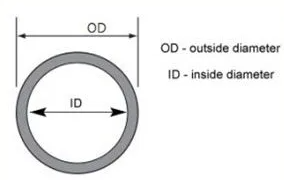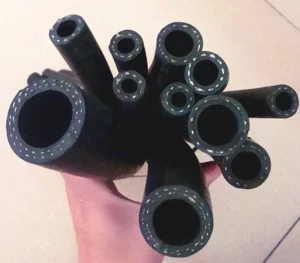
What is dash size?
People new to the hydraulic and pneumatic industries often ask: What is dash size? In short, dash size refers to the diameter of a hose, tube, or fitting in 1/16-inch increments.
Each dash size corresponds to a progressively larger diameter in sixteenths of an inch. A "-1" is 1/16", a "-2" is 2/16", and so on. In this case, a -6 hose would indicate a hose with an inside diameter of 6/16" or 3/8".
Another example, a -10 hose would indicate a hose with an outside diameter of 10/16" or 5/8".
Note that dash sizes for fittings are slightly different, with two sizes - one for the size of the fitting end connection and one for the hose size.
The chart below is usually organized by dash size and lists the corresponding hose or fitting size.
Note: Industry standard numbers indicate hose inside diameters in sixteenths of an inch. The exceptions are SAE 10R5, SAE 100R14 hoses, and SAEJ51 and SAE J2064 refrigerant hoses, where the dash number indicates the hose ID is equal to the equivalent OD (outside diameter)
| (All Except SAE 100R5, SAE100R14, SAEJ51 & SAEJ2064 ) | (SAE 100R5, SAE100R14, SAEJ51 & SAEJ2064 ) | |||
| Dash No. | Inches | Millimeters | Inches | Millimeters |
| -2 | 1/8 | 3.2 | -- | -- |
| -3 | 3/16 | 4.8 | -- | -- |
| -4 | 1/4 | 6.4 | 3/16 | 4.8 |
| -5 | 5/16 | 7.9 | 1/4 | 6.4 |
| -6 | 3/8 | 9.5 | 5/16 | 7.9 |
| -8 | 1/2 | 12.7 | 13/32 | 10.3 |
| -10 | 5/8 | 15.9 | 1/2 | 12.7 |
| -12 | 3/4 | 19 | 5/8 | 15.9 |
| -14 | 7/8 | 22.2 | -- | -- |
| -16 | 1 | 25.4 | 7/8 | 22.2 |
| -20 | 1-1/4 | 31.8 | 1-1/8 | 28.6 |
| -24 | 1-1/2 | 38.1 | 1-3/8 | 34.9 |
| -32 | 2 | 50.8 | 1-13/16 | 46 |
| -36 | 2-1/4 | 57.6 | -- | -- |
| -40 | 2-1/2 | 63.5 | 2-3/8 | 60.3 |
| -48 | 3 | 76.2 | -- | -- |
| -56 | 3-1/2 | 88.9 | -- | -- |
| -64 | 4 | 101.6 | -- | -- |
| -72 | 4-1/2 | 115.2 | -- | -- |
hose dash size chart
Did you notice that for hose part numbers we refer to the ID, and for hose part numbers we refer to the OD? That’s no accident. Hoses are measured by the ID, and hoses are measured by the OD, and that’s the difference.
Most people think of hoses as flexible and hoses as rigid, but in reality, there are some very rigid hoses, and some very flexible hoses. For example, nylon tubing is very flexible, while flexible metal hoses are (relatively) very rigid.
So remember: the dash size is the size of the hose, tube, or fitting, expressed in 1/16 of an inch. Hoses are measured by the ID, and hoses fitting are measured by the OD
The Importance of Choosing the Correct Dash Size
The importance of using the correct hose and fitting sizes in your hydraulic system cannot be overstated. Improper sizing can lead to a variety of problems that can negatively impact the performance and life of your system.
First, using the wrong size hose or fitting can cause leaks. This can lead to fluid loss, which in turn reduces the efficiency of the system and makes it more difficult to maintain the correct pressure. Leaks can also allow contaminants to enter the system, which can damage the equipment and shorten its life. In addition, if leaks are not promptly addressed, they can cause the system to fail completely.
Another problem caused by using the wrong size hose or fitting is reduced efficiency. A hose that is too small for a particular application will not be able to handle the correct fluid flow, resulting in increased pressure drop and reduced system performance. Similarly, a fitting that is too small will not provide an adequate seal, also resulting in pressure drop and reduced efficiency.
Finally, using the wrong size hose or fitting can also lead to equipment failure. For example, a hose that is too small may not be able to withstand the pressure and may burst, damaging the equipment and risking personal injury.
Therefore, it is critical to use the correct size and type of hose and fittings in your hydraulic system to ensure its safety, performance, and life. The dash size chart can be a helpful tool to ensure that the correct size and type of component is selected for a specific application.

Other hose diameters
Inner Diameter (I.D.), Outer Diameter (O.D.), Length. Essentially, understanding the basics of hydraulic hose selection is a bit like preparing a meal. You need to consider all the ingredients (inner diameter, outer diameter, length) and make sure they are in the correct proportions to make your hydraulic system work efficiently.
Understanding hydraulic hose panel sizes is essential to selecting the right hose for your specific application. By understanding the relationship between panel numbers and hose sizes, you can ensure proper fit, performance, and safety.
Remember that panel size is an important factor to consider when designing or maintaining a hydraulic system. Always consult the manufacturer's specifications for accurate sizing information to avoid potential issues associated with improper hose sizing.
Ready to view our comprehensive hydraulic hose sizing chart? Visit our official website today! Our chart provides detailed information on various hose sizes and their corresponding panel numbers, making it easy to select the hose that best suits your needs.
Don't compromise on performance and safety in your hydraulic system. Download our latest hydraulic hose sizing chart today to make an informed decision for your project
Need help navigating the world of hydraulic hoses? Contact us and our Hose experts are online to answer your questions.